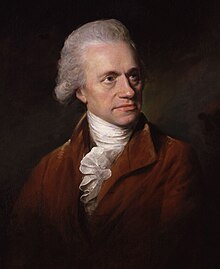
Back William Herschel Afrikaans ويليام هيرشل Arabic ويليام هيرشيل ARZ William Herschel AST Vilyam Herşel Azerbaijani ویلیام هرشل AZB Уільям Гершэль Byelorussian Ўільям Гэршэль BE-X-OLD Уилям Хершел Bulgarian উইলিয়াম হার্শেল Bengali/Bangla
William Herschel | |
|---|---|
 Portrait by Lemuel Francis Abbott, 1785 | |
| Born | Friedrich Wilhelm Herschel 15 November 1738 |
| Died | 25 August 1822 (aged 83) Slough, England |
| Resting place | St Laurence's Church, Slough |
| Nationality | Hanoverian British (after 1793)[1] |
| Known for |
|
| Spouse | Mary Baldwin Herschel |
| Children | John Herschel (son) |
| Relatives | Caroline Herschel (sister) |
| Awards | Copley Medal (1781) |
| Scientific career | |
| Fields | Astronomy and music |
| Signature | |
Frederick William Herschel[2][3] KH, FRS (/ˈhɜːrʃəl/;[4] German: Friedrich Wilhelm Herschel; 15 November 1738 – 25 August 1822) was a German-British[5] astronomer and composer. He frequently collaborated with his younger sister and fellow astronomer Caroline Herschel. Born in the Electorate of Hanover, William Herschel followed his father into the military band of Hanover, before emigrating to Great Britain in 1757 at the age of nineteen.
Herschel constructed his first large telescope in 1774, after which he spent nine years carrying out sky surveys to investigate double stars. Herschel published catalogues of nebulae in 1802 (2,500 objects) and in 1820 (5,000 objects). The resolving power of the Herschel telescopes revealed that many objects called nebulae in the Messier catalogue were actually clusters of stars. On 13 March 1781 while making observations he made note of a new object in the constellation of Gemini. This would, after several weeks of verification and consultation with other astronomers, be confirmed to be a new planet, eventually given the name of Uranus. This was the first planet to be discovered since antiquity, and Herschel became famous overnight. As a result of this discovery, George III appointed him Court Astronomer. He was elected a Fellow of the Royal Society and grants were provided for the construction of new telescopes.
Herschel pioneered the use of astronomical spectrophotometry, using prisms and temperature measuring equipment to measure the wavelength distribution of stellar spectra. In the course of these investigations, Herschel discovered infrared radiation.[6] Other work included an improved determination of the rotation period of Mars,[7] the discovery that the Martian polar caps vary seasonally, the discovery of Titania and Oberon (moons of Uranus) and Enceladus and Mimas (moons of Saturn). Herschel was made a Knight of the Royal Guelphic Order in 1816. He was the first President of the Royal Astronomical Society when it was founded in 1820. He died in August 1822, and his work was continued by his only son, John Herschel.
- ^ Hoskin, Michael (June 2013). "The Herschel knighthoods under scrutiny". Astronomy & Geophysics. 54 (3): 3.23–3.24. doi:10.1093/astrogeo/att080.
- ^ Hoskin, Michael, ed. (2003). Caroline Herschel's autobiographies. Cambridge: Science History Publ. p. 13. ISBN 978-0905193069.
- ^ "William Herschel | Biography, Education, Telescopes, & Facts". Encyclopedia Britannica. Retrieved 15 September 2021.
- ^ Wells, J. C. (2000). Longman Pronunciation Dictionary. Pearson Longman. p. 358. ISBN 978-0-582-36467-7.
- ^ "Sir William Herschel | British-German astronomer". 21 August 2023.
- ^ "Herschel discovers infrared light". Cool Cosmos. Archived from the original on 25 February 2012. Retrieved 6 June 2018.
- ^ Cite error: The named reference
Copuswas invoked but never defined (see the help page).
© MMXXIII Rich X Search. We shall prevail. All rights reserved. Rich X Search